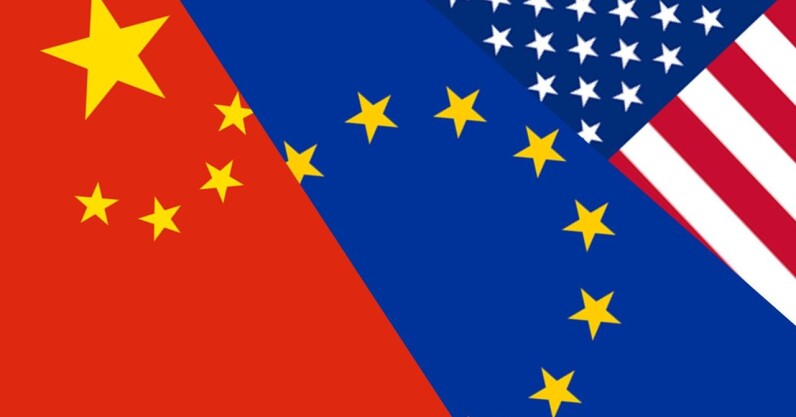Semiconductor chips have emerged as the hottest commodity in the global race for technological supremacy. That’s because they constitute a fundamental component of electronic devices, critical for advances in a vast array of industries: from telecoms, AI, and computing, to healthcare, clean energy, and military applications.
Historically, the EU and the US have relied heavily on East Asian countries for chip imports and supply of the necessary chipmaking materials. But following the invasion of Ukraine, increasing geopolitical tensions, especially with China, have intensified the demand for self-sufficiency in the West.
Signs of an escalating chip trade war were evident already in October last year. Now, a set of new strategic measures have further ignited the conflict, raising fears over the stability of the global supply chain, and even threatening to derail the EU’s green transition.
But how did it all come to this?
Strengthening supply resilience and manufacturing in the West
In 2021, the EU and the US established the Trade and Technology Council (TTC), seeking mutually beneficial cooperation.
Both parties committed to “… building a partnership on the rebalancing of global supply chains in semiconductors” seeking to enhance “their respective security of supply as well as their capacity to design and produce them.”
Individually, the EU has announced its €43bn Chips Act to bolster domestic production of semiconductor chips and increase its global market share from 10% to 20% by 2030.
“Microchips are the backbone of innovation and of Europe’s industrial competitiveness in a digital world,” remarked Margrethe Vestager, the Commission’s executive VP.
Similarly, the US is spending $52bn on its own Chips and Science Act to strengthen manufacturing and supply chains and, to “counter China.”
Handling China
In 2022, China remained the largest individual market for semiconductors, while it accounted for 26% of semiconductor production equipment sales. The government further plans to spend at least $150bn on semiconductors between 2020 and 2025, as part of a $1.4tn budget on an array of advanced technologies.
However, the country houses a significant industry concentration in the manufacturing of less advanced chips, and is therefore making efforts to ramp up domestic capacity of their more high-end equivalents — which it’s currently importing.
Decoupling
Citing national security concerns, the US has been taking steps to cripple Beijing’s ambitions.
The Biden Administration isn’t just implementing a technological — and economic — decoupling strategy, as seen in the Chips and Science Act. In October, it also introduced a series of comprehensive export rules aiming to restrict China from obtaining key chip technology.
Under the measures, US companies are restricted from selling machinery that can be used for high-end chip manufacturing to China. In addition, they’re required to obtain licences to export advanced chips that can be used in supercomputing and AI development. This also applies to foreign firms that use American tools or software in their design and production process.
According to reports, the Biden Administration is considering further export restrictions on AI chips as soon as this summer.
De-risking
In contrast to the US, the EU is taking a more nuanced approach, and has been campaigning for a “de-risking” strategy. “I believe it is neither viable — nor in Europe’s interest — to decouple from China,” said Commission president Von der Leyen in March. “Our relations are not black or white — and our response cannot be either. This is why we need to focus on de-risk — not decouple.”
Essentially, the bloc translates de-risking into two courses of action: building domestic capacity and strengthening its supply chain resilience with international partnerships.
Last week, for instance, EU Commissioner Thierry Breton visited Tokyo to deepen the union’s cooperation with Japan on semiconductor chips. The two will work together to track the chip supply chain and foster the exchange of researchers and engineers, Breton told Reuters. The bloc will also provide help to Japanese semiconductor companies that wish to operate within its borders.
The EU’s commitment to continue its trade collaboration with China — characterised as the bloc’s simultaneous “partner, competitor, and systemic rival” — was reconfirmed as part of the new European Economic Security Strategy, unveiled in June.
Boycotting
Brussel’s strategy also aims to further control exports and outbound investments in sensitive technologies, such as advanced semiconductors, quantum technologies, and AI, that can pose economic and national security risks.
Vestager has said that the strategy is “country-agnostic” and will use “geopolitical filters” when assessing the risks. Yet, China was mentioned both directly and indirectly.
“We can’t treat a supply dependency on a systemic rival the same way as we would on an ally,” Vestager noted. “It is no secret that Russia has inspired our energy security concerns. Likewise, in March, President von der Leyen said that China presents particular technology security and technology leakage concerns.”
Earlier in January, Breton stressed the union’s commitment to support the US goal of curbing China’s semiconductor industry. “We fully agree with the objective of depriving China of the most advanced chips,” he said during a speech at the Centre for Strategic and International studies. “We cannot allow China to access the most advanced technology in semiconductors, quantum, cloud, edge, AI, connectivity, and so on.”
On June 30, after months of pressure from the US, the Netherlands officially introduced stricter export controls of advanced chip manufacturing machines citing “national security interests.” Starting from September 1, Dutch companies in the industry will have to first obtain a permit before any shipments to countries that might use the technology for military applications — such as China.
The move strikes a heavy blow as the Netherlands is home to ASML, the world’s leading manufacturer of high-end chipmaking equipment. AMSL is already prohibited from selling its most sophisticated machines to China from 2019. According to the company, the new measures will also include its most advanced immersion DUV lithography systems.
China strikes back
When the Dutch plans were first unveiled in March, Chinese Ambassador Tan Jian remarked that such practices, instigated by the US and its allies, “violate international trade rules” and “undermine the global supply chains.”
In an interview with Het Financieele Dagblad, Tan noted that the DUV technology is by no means advanced, but is actually used for chips in consumer devices. He added that China has never “harmed” European interests, but warned that “there will be consequences” if the Dutch government went ahead with the restrictions.
Not surprisingly, shortly after the announcement from the Netherlands, China hit back in what is turning into an escalating chip war. Last Monday, the Chinese Ministry of Commerce announced export controls on sales of gallium and germanium, two metals critical to manufacturing electronics and semiconductors.
Starting from August 1, companies who wish to supply the metals overseas will have to apply for a licence and report on the details of the buyers and their applications. “National security concerns” were — once again — cited as the reason behind the move.
According to the European industry association Critical Raw Materials Alliance (CRMA), China produces 80% of the world’s gallium and 60% of germanium. Both metals are included in the EU’s list of critical raw materials, deemed “crucial to Europe’s economy.”
The metals aren’t particularly scarce or difficult to find, and there’s a handful of other countries who produce them. In the case of gallium, it’s Japan, South Korea, Russia, and Ukraine;for germanium, it’s Belgium, Canada, and Russia.
“China dominates production of these two metals not because they are rare, but because it has been able to keep their production costs fairly low and manufacturers elsewhere haven’t been able to match the country’s competitive costs,” Ewa Manthey, Commodities Strategist at ING, explained.
“A warning shot, not a fatal blow”
Analysts at the Eurasia Group characterise Beijing’s new measures as “a warning shot, not a fatal blow, intended to remind the West that China has retaliatory options.”
According to Manthey, the restrictions aren’t expected to cripple the industry, with markets and supply chains adjusting over time. “Initially, prices are likely to rise, but the move will give foreign manufacturers a push to diversify their supply chains and move production out of China,” she notes.
Supply diversification and curtailing reliance on China has in any case been part of the US’ and the EU’s strategy. Still, the export controls are enough to cause temporary instability and, most alarmingly, raise concerns over retribution.
In fact, China has the power to essentially obliterate the EU’s green transition, as the bloc moves towards a massive decarbonisation push across its entire economy.
The EU is currently 98% dependent on Beijing for access to rare earths, a series of metals that are crucial to manufacturing key technologies, such as hydrogen storage, solar, and wind power. It also relies entirely on imports of refined lithium (the main component of EV batteries), which is about 80% monopolised by… China.
“China is now starting to get serious about two metals,” said Robert Habeck, Germany’s Federal Minister for Economic Affairs and Climate Action, during an industry event. “If this is extended to lithium, for example, we would have a very different problem,” he warned.
The aftermath
While the Commission has yet to declare its position, Beijing’s warning seems to have served its purpose, with the US aiming to rekindle its relationship with China.
During her visit to the Chinese capital on Friday, US Treasury Secretary Janet Yellen told Chinese Premier Li Qiang: “We seek healthy economic competition that is not winner-take-all but that, with a fair set of rules, can benefit both countries over time.”
Toning down Washinghton’s previous rhetoric, Yellen stressed that the US is interested in de-risking trade, rather than decoupling the two economies. While no particular consensus was reached, for now, the countries want to keep their communication channels open.
At the time of writing, it’s still uncertain how the EU will choose to proceed in this high-stake conflict. But one thing is certain: its response will further shift the pieces on the geopolitical chessboard.



